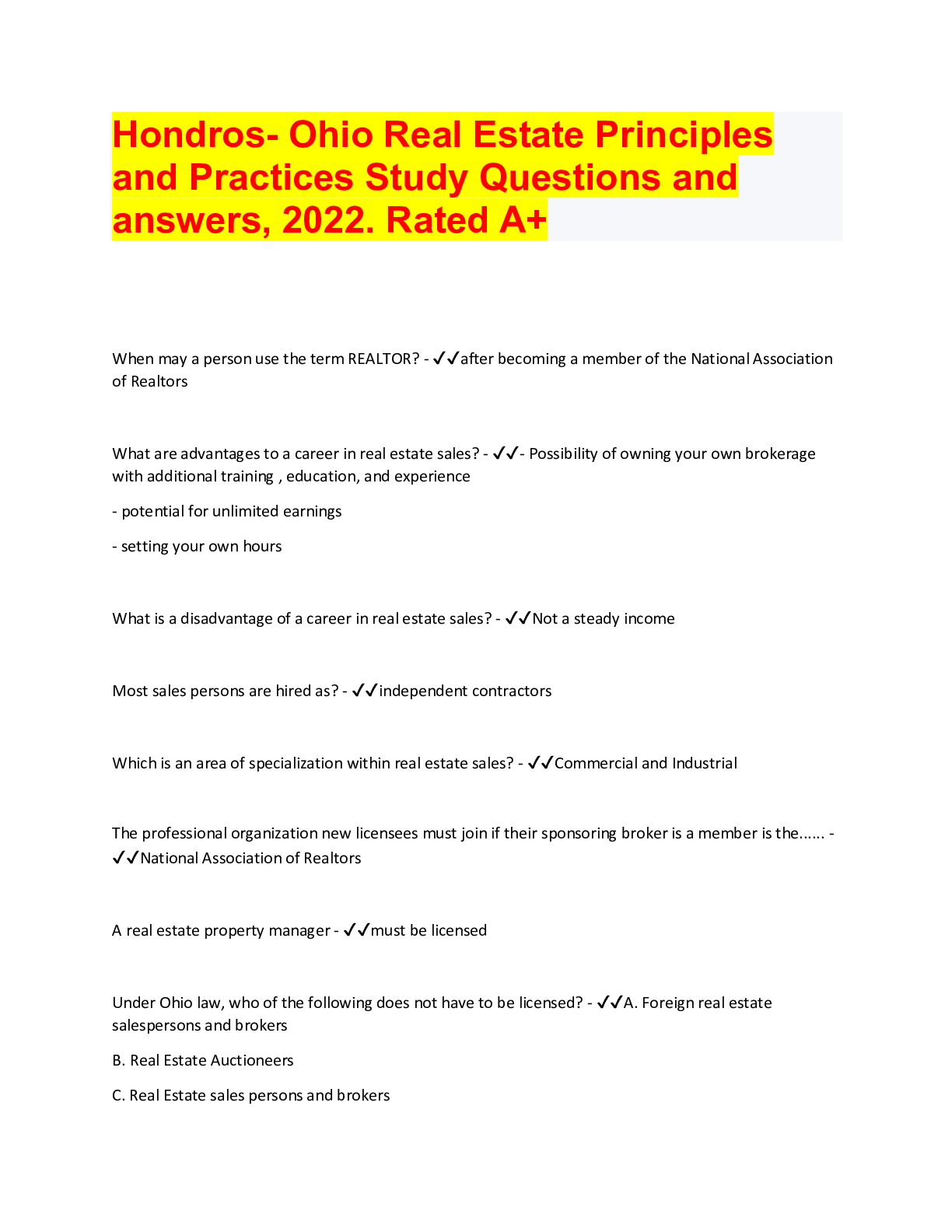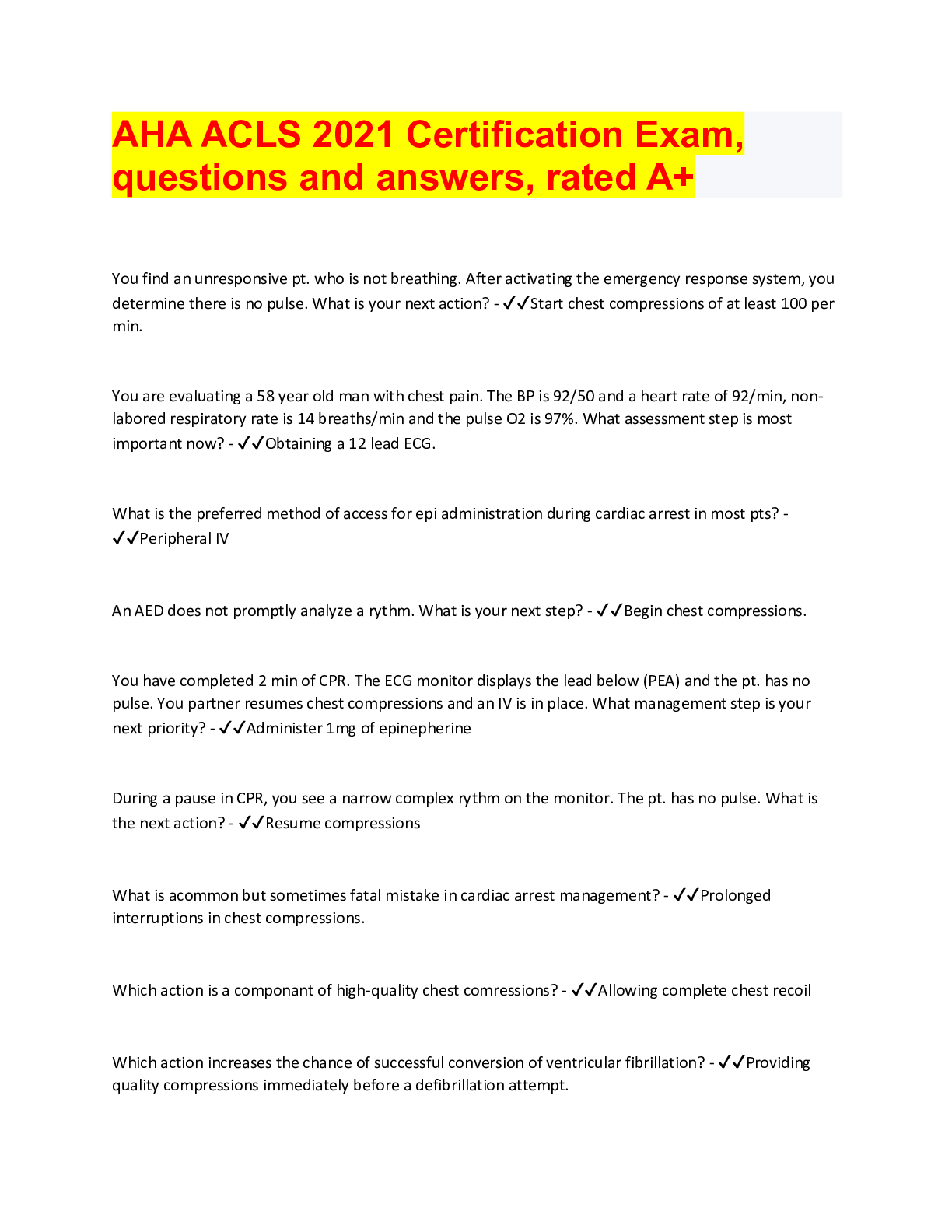Chemistry > QUESTIONS & ANSWERS > Chapter 20: Lipid Metabolism Exam, questions and answers Biochemistry. 100% (All)
Chapter 20: Lipid Metabolism Exam, questions and answers Biochemistry. 100%
Document Content and Description Below
Matching Choose the correct answer from the list. Not all the answers will be used. A) HDL B) propionyl-CoA C) LDL D) Dihydroxyacetone phosphate E) malonyl-CoA F) ACP G) chylomicrons H) pho... sphopantetheine I) flavin J) albumin K) ketone bodies L) cholesterol 1. Lipoproteins formed in the intestinal mucosal cells are called . Section: 20.1.B Level of Difficulty: Easy Learning Objective: Lipid Digestion, Absorption, and Transport 2. Cholesterol and other lipids are transported from tissues to the liver by . Section: 20.1.B Level of Difficulty: Easy Learning Objective: Lipid Digestion, Absorption, and Transport 3. The glycerol backbone of triacylglycerols is catabolized to . Section: 20.1.B Level of Difficulty: Easy Learning Objective: Lipid Digestion, Absorption, and Transport 4. Free fatty acids bind to for circulation in the bloodstream. Section: 20.2 Level of Difficulty: Easy Learning Objective: Fatty Acid Oxidation 5. Cells take up by receptor mediated endocytosis. Section: 20.1.B Level of Difficulty: Easy Learning Objective: Fatty Acid Oxidation 6. The oxidation of odd-numbered fatty acids results in as a final product. Section: 20.2.E Level of Difficulty: Easy Learning Objective: Fatty Acid Oxidation 7. The molecules acetoacetate, acetone, and D--hydroxybutyrate are metabolic fuels termed . Section: 20.3 Level of Difficulty: Easy Learning Objective: Ketone Bodies 8. Acyl carrier protein (ACP) contains a prosthetic group. Section: 20.4.C Level of Difficulty: Easy Learning Objective: Fatty Acid Biosynthesis 9. Fatty acid synthesis requires both acetyl-CoA and as initiator molecules. Section: 20.4.B Level of Difficulty: Easy Learning Objective: Fatty Acid Biosynthesis 10. is formed from ordered sequence of condensation of isoprene units. Section: 20.7.A Level of Difficulty: Easy Learning Objective: Cholesterol Metabolism Multiple Choice 11. Digestion of triacylglycerols is aided by the cholesterol derivatives synthesized by the liver known as A) bile acids. B) lipoproteins. C) lanosterols. D) chylomicrons. E) colipases. Section: 20.1.A Level of Difficulty: Moderate Learning Objective: Lipid Digestion, Absorption, and Transport 12. Which of the following would result in a net increase in uptake of LDL by the liver? A) increased availability of LDL receptors B) high levels of cholesterol synthesis C) increased availability of clathrin triskelions D) all of the above E) none of the above Section: 20.1.B Level of Difficulty: Difficult Learning Objective: Lipid Digestion, Absorption, and Transport 13. Which of the following is required for entry of fatty acids into the oxidation pathway? I. priming via the enzyme acyl CoA synthetase II. conservation of free energy from ATP hydrolysis by use of a thioester linkage III. transport to the cytosol for oxidation via a carnitine carrier protein IV. hydrolysis of carnitine palmitoyl transfer protein A) I, II B) I, II, III C) I, II, III, IV D) III, IV E) I, III Section: 20.2.A Level of Difficulty: Difficult Learning Objective: Fatty Acid Oxidation 14. Which of the following vitamins is part of the prosthetic group 5-deoxyadenosylcobalamin? A) B1 B) B2 C) B6 D) B12 E) none of the above Section: 20.2.E Level of Difficulty: Easy Learning Objective: Fatty Acid Oxidation 15. , a condition in which acetoacetate production exceeds it metabolism and results in a sweet breath odor due to nonenyzmatic of acetoacetate to . A) ketosis; decarboxylation; hydroxylbutryate B) ketosis; carboxylation; hydroxylbutryate C) ketosis; carboxylation; acetone D) glyceroneogenesis; decarboxylation; hydroxylbutryate E) glyceroneogenesis; decarboxylation; acetone Section: 20.3 Level of Difficulty: Moderate Learning Objective: Ketone Bodies 16. Triacylglycerols are synthesized by during times of starvation via a process known as . A) Dihydroxyacetone phosphate; ketosis B) Dihydroxyacetone phosphate; glyceroneogenesis C) acetyl CoA; ketosis D) acetyl CoA; glyceroneogenesis E) ketone bodies; ketosis Section: 20.4.E Level of Difficulty: Moderate Learning Objective: Fatty Acid Biosynthesis 17. Two phosphatidylglycerol molecules condense to form the molecule , and glycerol is eliminated as the side product. A) phosphatidic acid B) cardiolipin C) plasmalogen D) sphingomyelin E) squalene Section: 20.6.B Level of Difficulty: Easy Learning Objective: Synthesis of Other Lipids 18. The activity of lipases is controlled in part by a process known as which functions effectively due to the where lipases are active. A) interfacial activation; lipid-water interface B) lipase activation; lipid-water interface C) lipase activation; bile salt-water interface D) micelle activation; water-salt interface E) none of the above Section: 20.1.A Level of Difficulty: Moderate Learning Objective: Lipid Digestion, Absorption, and Transport 19. Which of the following accurately ranks lipoproteins from highest to lowest density? A) chylomicrons > HDL > LDL > IDL > VLDL B) HDL > IDL > LDL > VLDL > chylomicrons C) HDL > LDL > IDL > VLDL > chylomicrons D) chylomicrons > VLDL > IDL > LDL > HDL E) VLDL > IDL > LDL > HDL > chylomicrons Section: 20.1.B Level of Difficulty: Moderate Learning Objective: Lipid Digestion, Absorption, and Transport 20. Which of the following statements about apolipoproteins (with the possible exception of apoB-100) is TRUE? I. The apolipoproteins are water-soluble and loosely associate with the lipoproteins. II. The apolipoproteins contain helices with hydrophobic and hydrophilic groups on opposite sides of the helical cylinder. III. The apolipoproteins are synthesized in the intestinal tissues. IV. The apolipoproteins appear to float on the surface of phospholipids. A) I only B) I and II C) III, IV D) I, II, III E) I, II, IV Section: 20.1.B Level of Difficulty: Moderate Learning Objective: Lipid Digestion, Absorption, and Transport 21. Knoop’s experiments with fatty acids A) involved the novel use of chemical labels to elucidate metabolic mechanisms. B) demonstrated that fatty acids are broken down by two carbons at a time by oxidation at the ω carbon. C) demonstrated a distinct difference in the mechanism of odd chain versus. even chain fatty acid oxidation. D) A and B E) A, B, and C Section: 20.2 Level of Difficulty: Difficult Learning Objective: Fatty Acid Oxidation 22. Which of the following statements about peroxisomes is FALSE? A) oxidation in peroxisomes can shorten very long fatty acids. B) Mammalian peroxisomes can synthesize some lipids, including bile salts. C) In plants, peroxisomes and glyoxysomes serve as the site of oxidation. D) Long chain fatty acids are transported into the peroxisome via a carnitine carrier protein where they are activated for oxidation. E) oxidation in peroxisomes varies slightly from the mitochondrial process. Section: 20.2.F Level of Difficulty: Difficult Learning Objective: Fatty Acid Oxidation 23. An important structural lipid found in nerve cell membranes, , is a type of . A) sphingomyelin, phospholipid B) phosphatidylcholine, phospholipid C) palmitate, glycerophospholipid D) glucagon, hormone E) none of the above Section: 20.6.B Level of Difficulty: Moderate Learning Objective: Synthesis of Other Lipids 24. Pain and inflammation are triggered by which are synthesized by an enzyme inhibited by . A) cardiolipins; aspirin B) prostaglandins; aspirin C) analgesics; statins D) prostaglandins; COX-1 E) cyclooxygen; NSAIDS Section: 20.6.C Level of Difficulty: Moderate Learning Objective: Synthesis of Other Lipids 25. Cholesterol is a precursor to I. prostaglandins II. vitamin K III. steroid hormones such as androgens 164 IV. bile acids A) I, III, IV B) I, II, III, IV C) III only D) IV only E) III, IV Section: 20.7 Level of Difficulty: Easy Learning Objective: Cholesterol Metabolism 26. Which of the following best describes arachidonic acid? A) a 20-carbon isoprene-based intermediate of cholesterol synthesis B) a 20-carbon fatty acid essential for cholesterol synthesis C) a 20-carbon isoprene-based compound used for synthesis of prostaglandins D) a 20-carbon fatty acid used for synthesis of prostaglandins E) a 2-carbon compound that functions in conjunction with a fatty acid carrier protein for transport of primed fatty acids Section: 20.6.C Level of Difficulty: Easy Learning Objective: Synthesis of Other Lipids 27. Which of the following compounds are required to make sphingosine? I. palmitoyl-CoA II. serine III. acetyl-CoA IV. isoprene V. arachidonic acid A) I, II B) I, III C) II, IV D) IV, V E) II, V Section: 20.6.B Level of Difficulty: Moderate Learning Objective: Synthesis of Other Lipids 28. In which location listed below does the following reaction take place? HMG-CoA → acetoacetate + Acetyl-CoA A) cytosol of cardiomyocytes B) mitochondria of cardiomyocytes C) cytosol of liver cells D) mitochondria of liver cells 165 E) all of the above Section: 20.3 Level of Difficulty: Moderate Learning Objective: Ketone Bodies 29. In which cellular compartment does the following reaction take place? HMG-CoA + 2 NADPH → mevalonate + 2 NADP+ + Acetyl-CoA A) cytosol of liver cells B) mitochondria of liver cells C) cells in the intestinal lumen D) lysosomal fluid E) all of the above Section: 20.7.A Level of Difficulty: Moderate Learning Objective: Cholesterol Metabolism 30. Which enzyme catalyses the key regulatory step of cholesterol synthesis? A) -ketothiolase B) HMG-CoA synthase C) HMG-CoA reductase D) mevalonate-5-phosphotransferase E) phenyltransferase Section: 20.7.A Level of Difficulty: Easy Learning Objective: Cholesterol Metabolism 31. Sphinganine is an intermediate in the synthesis of which of the following? I. ceramides II. spingomyelins III. cerebrosides IV. prostaglandins A) I only B) I, II C) I, II, III D) II, III E) I, II, IV Section: 20.6.B Level of Difficulty: Difficult Learning Objective: Synthesis of Other Lipids 166 32. Which of the following is TRUE regarding the enzyme acetyl-CoA carboxylase? I. It catalyzes the first committed step in fatty acid oxidation. II. It requires S-adenosylmethionine. III. It produces malonyl CoA IV. It uses acetyl CoA A) I, II, III, IV B) I only C) I, III, IV D) III, IV E) III only Section: 20.4.B Level of Difficulty: Difficult Learning Objective: Fatty Acid Biosynthesis 33. What is the net production of ATP from complete catabolism of the following fatty acid to CO2 and H2O? A) < 50 B) 51 – 90 C) 91 - 120 D) 121 - 150 E) 151 + Section: 20.4.B Level of Difficulty: Moderate Learning Objective: Fatty Acid Biosynthesis 34. Which of the following could be produced by the reaction of two or more of phosphatidic acids with two or more glycerol-3-phosphates? I. phosphatidylglycerol II. cardiolipin III. phosphatidylinositol IV. gangliosides A) I, II, III, IV B) II, III C) I, III D) I, II E) III only Section: 20.6.A Level of Difficulty: Difficult Learning Objective: Synthesis of Other Lipids 35. The mechanism of the condensing enzyme (KS) of fatty acid synthase is best described as 167 A) base catalysis using a glu residue in the active site B) acid catalysis using a glu residue in the active site C) base catalysis using a cys residue in the active site D) acid catalysis using a cys residue in the active site E) covalent catalysis using a cys residue in the active site Section: 20.4.C Level of Difficulty: Difficult Learning Objective: Fatty Acid Biosynthesis 36. Which statement concerning fatty acid synthesis is TRUE? I. The process occurs in the cytosol. II. In eukaryotes, the process occurs on a single large protein. III. The growing acyl chain is carried on an acyl carrier protein instead of coenzyme A. IV. The process requires two NADPH per acetyl group (2 carbons) added. A) I, II B) II, III C) I, II, III, IV D) III, IV E) I, III, IV Section: 20.4.C Level of Difficulty: Moderate Learning Objective: Fatty Acid Biosynthesis 37. Which of the following diets would most likely promote the formation of ketone bodies? A) high simple carbohydrates, low fat B) high complex carbohydrates, high fructose C) high fat, high protein, low carbohydrate D) low fat, high protein, high complex carbohydrates E) high fructose; high whole grain carbohydrates Section: 20.3 Level of Difficulty: Difficult Learning Objective: Ketone Bodies 38. Which statement concerning phospholipid synthesis is true? A) Addition of polar “head groups” to diacylglycerol usually involves CDP derivatives. B) Addition of polar “head groups” to diacylglycerol usually involves UDP adducts. C) Addition of fatty acyl “tails” to glycerol usually involves CDP adducts. D) Addition of fatty acyl “tails” to glycerol usually involves UDP adducts. E) None of the above is true. 168 Section: 20.6.A Level of Difficulty: moderate Learning Objective: Synthesis of Other Lipids 39. An enzyme that is inhibited by the statin group of drugs (e.g. Lipitor®) is A) phospholipase a2. B) hormone sensitive lipase. C) HMG CoA reductase. D) desaturase. E) glycerol kinase. Section: 20.7 Level of Difficulty: Easy Learning Objective: Cholesterol Metabolism 40. Which of the following is the source of the two carbon fragments in fatty acids biosynthesis? A) acetyl CoA B) malonyl CoA C) palmitic acid D) propionyl CoA E) ceramides Section: 20.4.C Level of Difficulty: Easy Learning Objective: Fatty Acid Biosynthesis 41. Which of the following is the starting metabolite in ketone body biosynthesis? A) acetyl CoA B) malonyl CoA C) propionlyl CoA D) acetyl CoA and propionyl CoA E) acetyl CoA and malonyl CoA Section: 20.3 Level of Difficulty: Learning Objective: Ketone Bodies 42. Which of the following is FALSE regarding HMG-CoA reductase? A) HMG-CoA reductase is highly regulated. B) The active site is tightly bound by statins. C) HMG-CoA reductase levels are increased as a result of high cholesterol concentrations in the ER D) HMG-CoA reductase levels are decreased as a result of high cholesterol concentrations in the ER. 169 E) HMG-CoA reductase is levels are decreased by the same factor that down regulated production of the LDL receptors Section: 20.7.A.B Level of Difficulty: Moderate Learning Objective: Cholesterol Metabolism 43. Considering the figure below, what compound would be formed by action of acyl-CoA dehydrogenase? A) B) C) D) E) Section: 20.2.C Level of Difficulty: Moderate Learning Objective: Fatty Acid Oxidation 44. Which of the following drugs acts by acetylating a serine residue preventing adequate enzyme activity? A) ibuprofen B) acetaminophen C) Vioxx® D) aspirin E) Celebrex® 170 Section: 20.6.C Level of Difficulty: Easy Learning Objective: Synthesis of Other Lipids 45. PGH2 is synthesized from and triggers pain and . A) cardiolipins; foam cell development B) steroids; fever C) salicylic acid; foam cell development D) NSAIDS; COX-1 E) arachidonate; inflammation Section: 20.6.C Level of Difficulty: Easy Learning Objective: Synthesis of Other Lipids 46. Which of the following enzymes is NOT involved in the tricarboxylate transport system? A) citrate synthase B) ATP citrate lyase C) malate dehydrogenase D) malic enzyme E) All are involved in the transport of acetyl-CoA into the cytosol Section: 20.4.A Level of Difficulty: Easy Learning Objective: Fatty Acid Biosynthesis 47. Which of the following components would be condensed to form acetoacetate? A) acetyl CoA and acetyl-CoA B) HMG-CoA and acyl-CoA C) acetone and betahydroxybutyrate D) malonyl-CoA and acyl-CoA E) DHAP and glycerol-3-phosphate Section: 20.3 Level of Difficulty: Easy Learning Objective: Ketone Bodies 48. Which of the following is the correct sequence of events in cholesterol synthesis? (Note: not all events in the sequence are included) A) HMG-CoA > isopentyl pyrophosphate > farnesyl pyrophosphate > geranyl pyrophosphate B) isopentyl pyrophosphate > squalene > oxidosqualene > geranyl pyrophosphate C) dimethylallyl pyrophosphate > geranyl pyrophosphate > farnesyl pyrophosphate > squalene D) HMG –CoA > phosphomevalonate > squalene > farnesyl pyrophosphate 171 E) mevalonate > dimethylallyl pyrophosphate > farnesyl pyrophosphate > gernayl pyrophosphate Section: 20.7 Level of Difficulty: Difficult Learning Objective: Cholesterol Metabolism 49. Which of the following compounds is produced by the multistep cyclization of squalene? A) lanosterol B) geranyl pyrophosphate C) fanesyl pyrophosphate D) isoprene E) isopentyl pyrophosphate Section: 20.7 Level of Difficulty: Easy Learning Objective: Cholesterol Metabolism 50. Which of the following is NOT an example of a problem sometimes associated with unsaturated fatty acid breakdown? A) β, double bond B) α, β double bond C) unanticipated isomerization D) inhibition of hydratase by a double bond E) All of the above are problems. Section: 20.2.D Level of Difficulty: Moderate Learning Objective: Fatty Acid Oxidation 51. LDL taken up by the liver is A) broken down into fatty acids and amino acids. B) taken up by the ER and used to control synthesis of HMG CoA reductase and LDL receptor synthesis. C) converted into clathrin and recycled. D) irreversibly bound to LDL receptors. E) excreted in a clathrin coated vesicle. 172 Section: 20.2.B Level of Difficulty: Moderate Learning Objective: Lipid Digestion, Absorption, and Transport 173 [Show More]
Last updated: 2 years ago
Preview 1 out of 15 pages

Buy this document to get the full access instantly
Instant Download Access after purchase
Buy NowInstant download
We Accept:

Reviews( 0 )
$6.50
Can't find what you want? Try our AI powered Search
Document information
Connected school, study & course
About the document
Uploaded On
Mar 13, 2020
Number of pages
15
Written in
Additional information
This document has been written for:
Uploaded
Mar 13, 2020
Downloads
1
Views
744






.png)
.png)
.png)
.png)
.png)
.png)
.png)

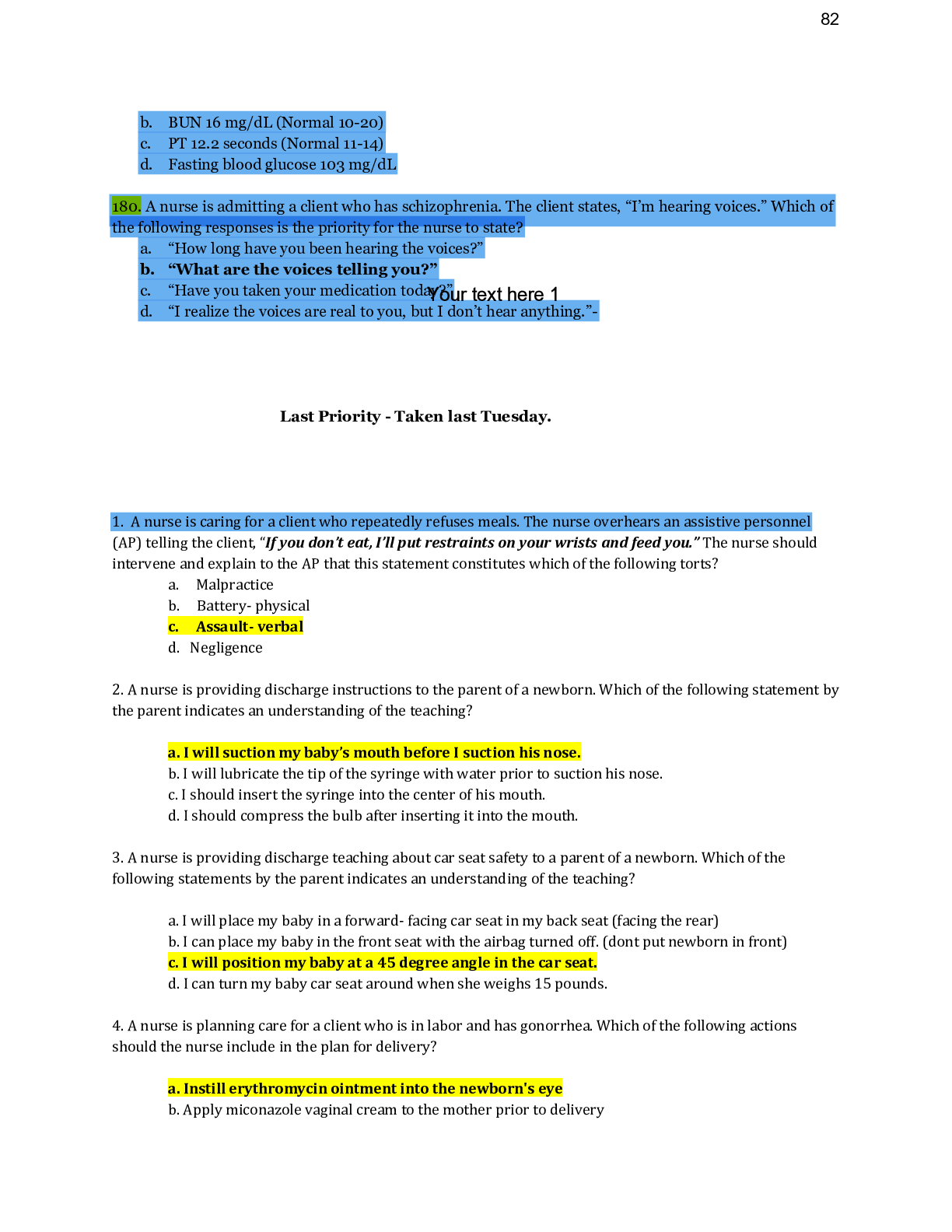
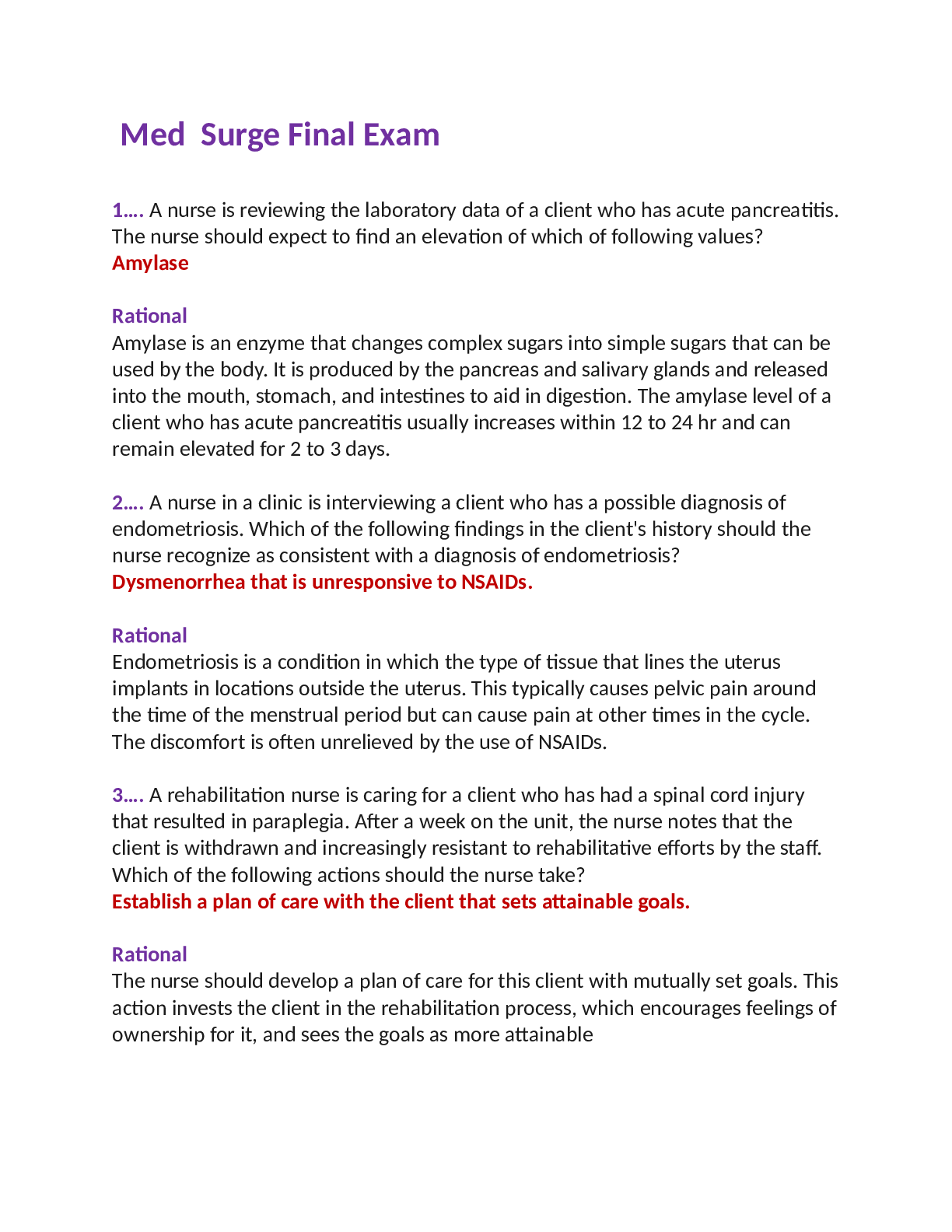
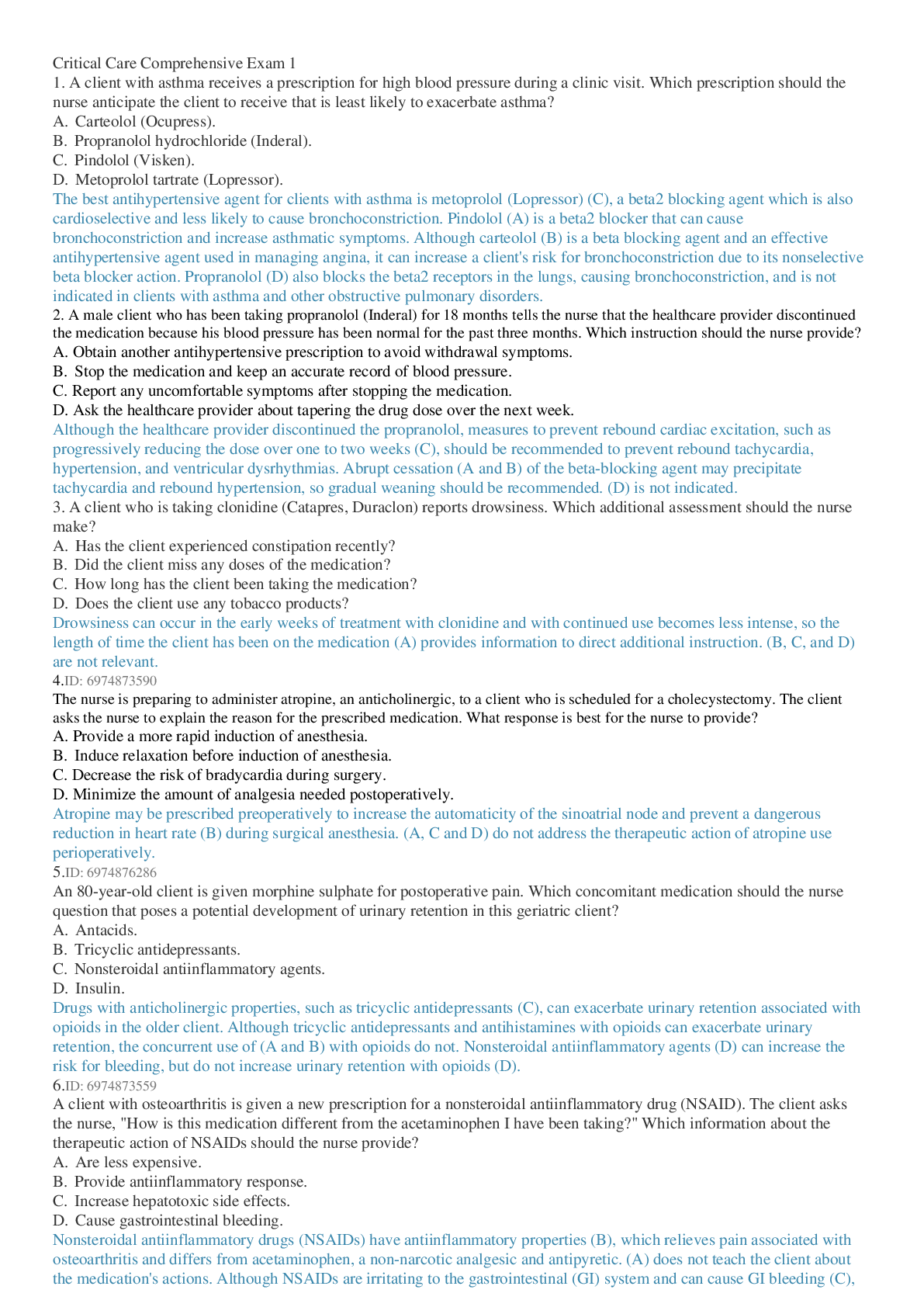
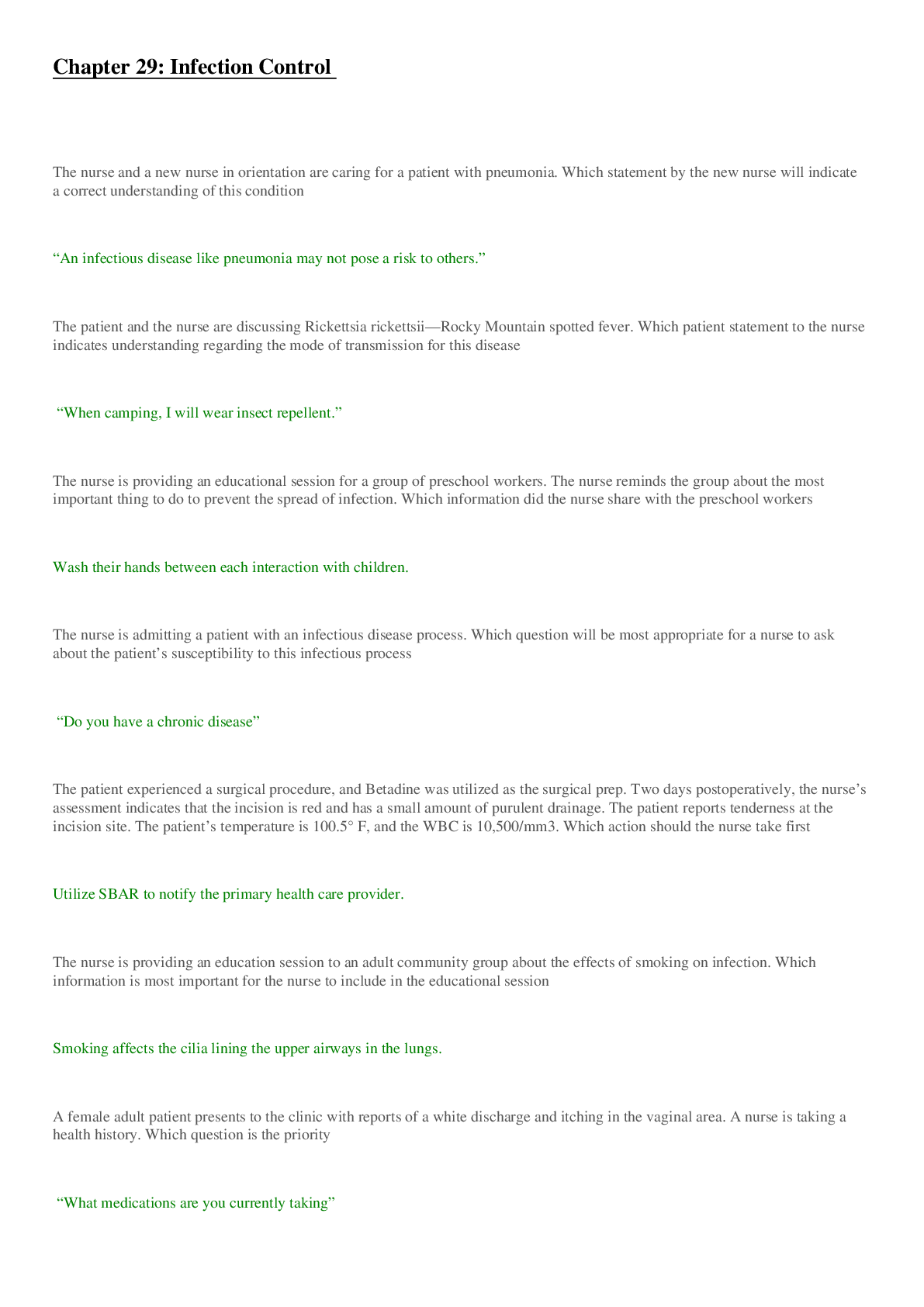

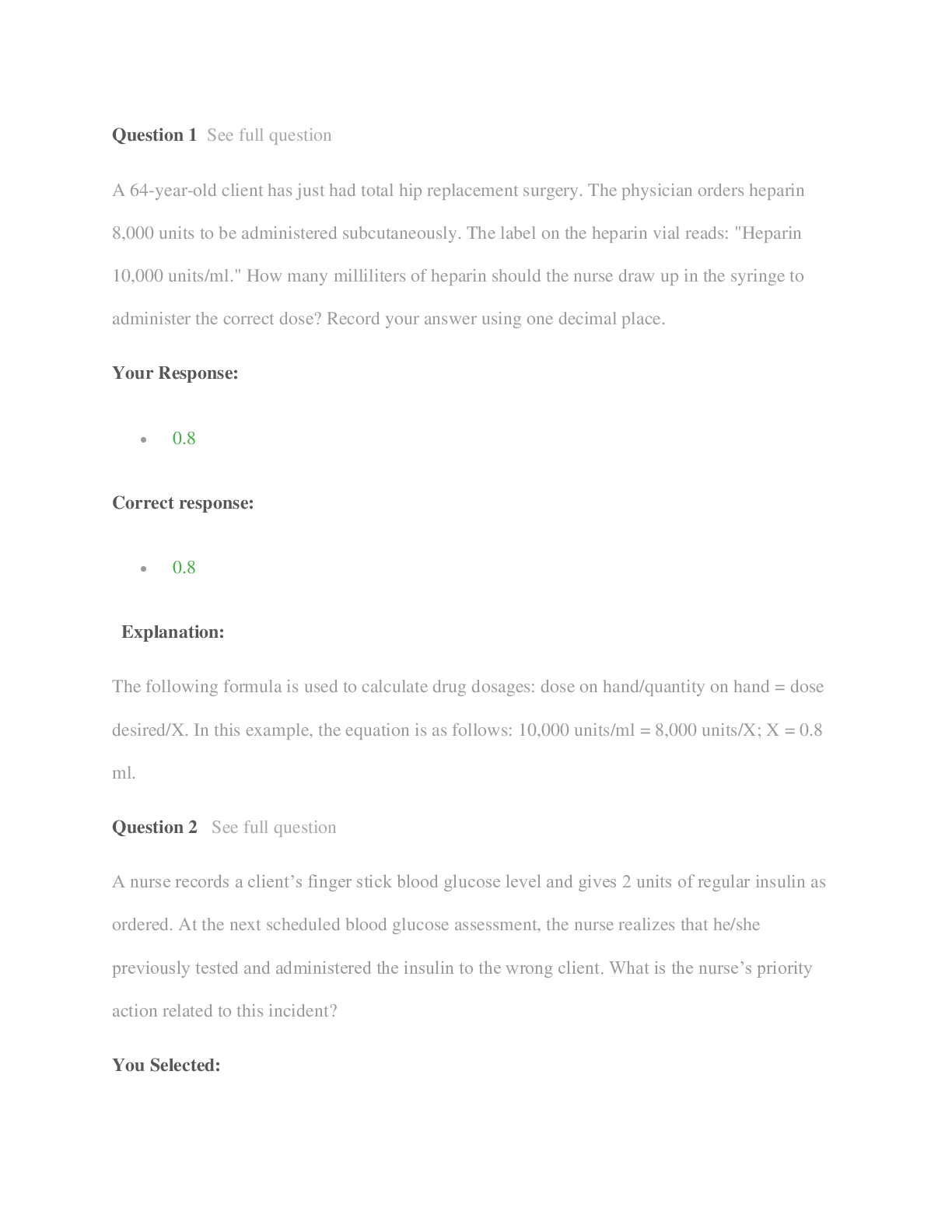

, All Correct, Download to Score A.png)
